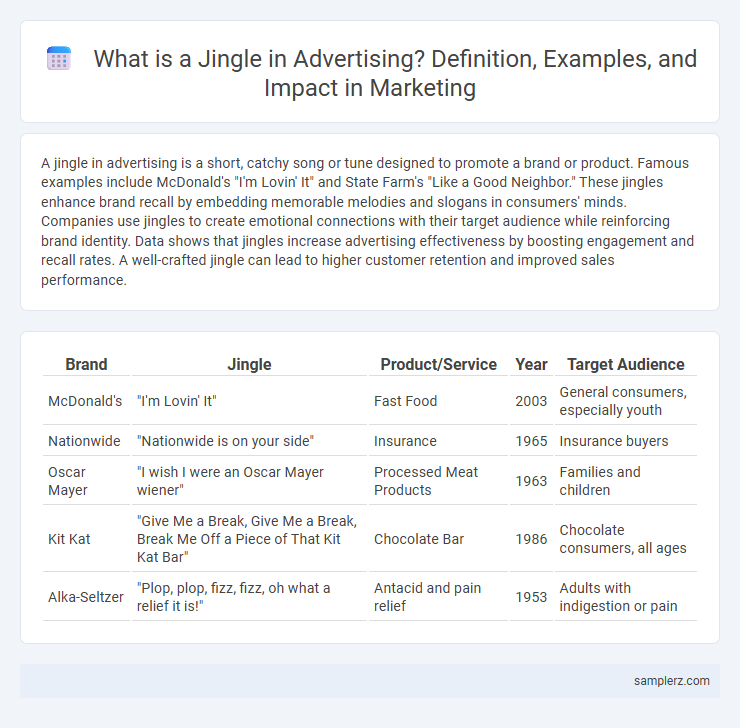A jingle in advertising is a short, catchy song or tune designed to promote a brand or product. Famous examples include McDonald's "I'm Lovin' It" and State Farm's "Like a Good Neighbor." These jingles enhance brand recall by embedding memorable melodies and slogans in consumers' minds. Companies use jingles to create emotional connections with their target audience while reinforcing brand identity. Data shows that jingles increase advertising effectiveness by boosting engagement and recall rates. A well-crafted jingle can lead to higher customer retention and improved sales performance.
Table of Comparison
| Brand | Jingle | Product/Service | Year | Target Audience |
|---|---|---|---|---|
| McDonald's | "I'm Lovin' It" | Fast Food | 2003 | General consumers, especially youth |
| Nationwide | "Nationwide is on your side" | Insurance | 1965 | Insurance buyers |
| Oscar Mayer | "I wish I were an Oscar Mayer wiener" | Processed Meat Products | 1963 | Families and children |
| Kit Kat | "Give Me a Break, Give Me a Break, Break Me Off a Piece of That Kit Kat Bar" | Chocolate Bar | 1986 | Chocolate consumers, all ages |
| Alka-Seltzer | "Plop, plop, fizz, fizz, oh what a relief it is!" | Antacid and pain relief | 1953 | Adults with indigestion or pain |
Understanding Jingles: Definition and Purpose in Advertising
Jingles are short, catchy musical phrases designed to enhance brand recall and create emotional connections with consumers. These memorable tunes condense key brand messages into easily recognizable audio signatures, boosting advertising effectiveness. Companies like McDonald's with "I'm Lovin' It" demonstrate how jingles increase consumer engagement and drive purchase behavior.
The History of Jingles in Marketing Campaigns
The history of jingles in marketing campaigns dates back to the 1920s with the first radio commercial jingle created for Wheaties, which helped establish brand recognition through catchy tunes. Iconic examples include McDonald's "I'm Lovin' It" and Oscar Mayer's "I Wish I Were an Oscar Mayer Wiener," both demonstrating how memorable melodies boost consumer recall and engagement. These jingles remain vital tools for building emotional connections and enhancing brand identity in competitive markets.
Iconic Jingle Examples from Global Brands
Coca-Cola's "I'd Like to Buy the World a Coke" jingle has become an emblem of unity and refreshment, resonating with audiences worldwide since the 1970s. McDonald's "I'm Lovin' It" campaign, launched in 2003, features a catchy melody that reinforces brand loyalty across diverse markets. Intel's five-note sonic logo, introduced in 1994, exemplifies minimalist yet memorable audio branding that instantly identifies the tech giant.
How Jingles Influence Consumer Behavior
Jingles create strong auditory brand associations that enhance recall and emotional connection, making products more memorable to consumers. The repetition of catchy melodies in jingles increases brand recognition, influencing purchase decisions by embedding the brand message in consumers' minds. Effective jingles leverage rhythm and rhyme to build trust and familiarity, driving consumer loyalty and boosting sales performance.
Elements of a Successful Advertising Jingle
A successful advertising jingle combines a catchy melody, memorable lyrics, and a clear brand message to create lasting consumer recall. Incorporating repetitive hooks and engaging rhythms enhances auditory recognition and strengthens emotional connections with the target audience. Effective jingles often align with the brand's identity and product benefits to drive customer loyalty and increase market presence.
Case Study: Memorable Jingles in Television Commercials
Coca-Cola's "I'd Like to Buy the World a Coke" jingle became an iconic example of emotional branding through music, significantly boosting brand recall and customer loyalty. McDonald's "I'm Lovin' It" jingle, launched in 2003, generated global recognition and increased market share by connecting with younger audiences through catchy and repetitive tunes. Intel's four-note sonic logo reinforced brand identity consistently across television commercials, showcasing the power of minimalistic yet memorable jingles in advertising effectiveness.
The Role of Music and Lyrics in Effective Jingles
Music and lyrics in jingles enhance brand recall by creating catchy and memorable sound bites that resonate with target audiences. Effective jingles use repetitive melodies and simple, impactful phrases to embed brand messages deeply into consumer memory. Brands like McDonald's ("I'm Lovin' It") and Intel ("Intel Inside") showcase how strategic musical hooks paired with clear lyrics drive emotional connections and consumer engagement.
Modern Adaptations: Jingles in Digital Advertising
Modern adaptations of jingles in digital advertising often incorporate catchy melodies with interactive elements such as clickable sound bites and personalized audio experiences. Brands leverage social media platforms and streaming services to create shareable jingles that resonate with target audiences through data-driven customization. These digital jingles enhance brand recall by blending traditional musical hooks with contemporary technology like AI-generated variations and augmented reality soundscapes.
Tips for Creating a Catchy Jingle for Your Brand
Creating a catchy jingle involves using simple, memorable melodies paired with clear, concise lyrics that reflect your brand's core message. Incorporating repetition and a strong hook helps embed the jingle in the audience's mind, increasing recall and brand recognition. Analyzing successful jingles from top marketing campaigns, such as McDonald's "I'm Lovin' It" or Intel's iconic four-note chime, can provide valuable insight into effective auditory branding strategies.
Measuring the Impact of Jingles on Brand Recognition
Jingles like McDonald's "I'm Lovin' It" significantly enhance brand recall by creating emotional connections and improving memory retention among consumers. Research shows that brands using catchy, repetitive jingles experience a measurable increase in unprompted brand recognition by up to 50%. Tracking metrics such as consumer surveys, recall tests, and digital engagement rates provides valuable insights into the effectiveness of jingles in advertising campaigns.

example of jingle in advertising Infographic
 samplerz.com
samplerz.com